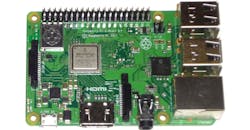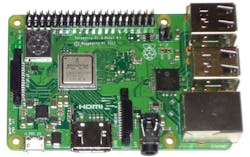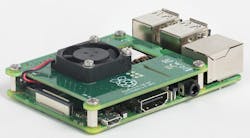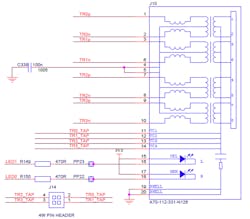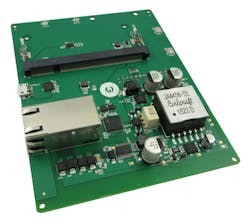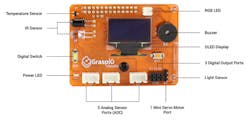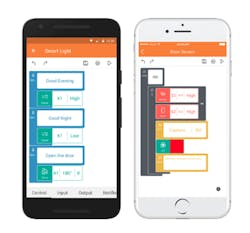The Raspberry Pi 3 Model B+ (Fig. 1) brings a performance boost with a 1.4 GHz Broadcom BCM2837B0 based around a quad core ARM Cortex-A53. It is available from a number of sources, including Newark Element 14 and AdaFruit. It retains the 1 Gbyte of DRAM of its predecessor, the Model B, but adds support for 2.4GHz and 5GHz IEEE 802.11.b/g/n/ac WiFi and Bluetooth 4.2 plus BLE support. The dual-band Wi-Fi will be very handy in wireless challenging environments. And it is still only $35.
1. The Raspberry Pi 3 Model B+ provides slight better processor performance, but significantly improves wireless performance and adds PoE support.
The Gigabit Ethernet support is via a USB 2.0 interface that provides a maximum throughput of 300 Mbits/s. The Ethernet support will also work with the forthcoming Power-over-Ethernet (PoE) Raspberry Pi adapter (Fig. 2). The 802.3af PoE support includes a controlled, 25-mm by 25-mm cooling fan and a fully isolated switched-mode power supply Raspberry Pi and limited peripherals. It is a Class 2 device that supports 37–57V DC inputs delivering 5V DC at 2.5 A.
2. Raspberry Pi 3 Model B+ PoE support is enabled when the PoE hat is installed. It also includes a small cooling fan.
The mods needed on the Raspberry Pi to support PoE are rather minor and found only on the Model B+. Essentially four of the eight wires on the RJ-45 Ethernet jack are used to deliver power (Fig. 3). These signals are brought out to a 4-pin header. The alternative is to come up with an external cable kludge that winds up being larger than the Raspberry Pi. Power is delivered to the Raspberry Pi using its peripheral connector. This approach also means additional PoE options are available, like IVMECH’s implementation.
3. The Raspberry Pi 3 Model B+ brings out the four wires on the Ethernet jack used for PoE to a 4-pin header.
Neither implementation provides a pass-through header for additional peripheral support. Placing a Pi hat with a passthrough header will not work because the PoE header must attach directly to the PoE board.
PoE for Delivery
The online discussions about the PoE support are interesting as many hobbyist and developers overlook its advantages. On the other hand, developers looking to deliver a product, which are a significant portion of the Raspberry Pi shipments, will appreciate the simplified wiring and deployment. PoE-enabled Ethernet switches are commonly available and utilized for applications ranging from wireless access points to IP cameras and phones. My security system uses PoE IP cameras and only needs a single Ethernet cable simplifying camera placement.
There are other alternatives for PoE support of the Raspberry Pi, like that found on the Gumstix Pi Conduit PoE board (Fig. 4). This supports a Raspberry Pi Compute module and the Model B+ version is not available, yet. It was designed using Gumstix’s Geppetto design-to-order (D2O) tool. Geppetto now supports PoE, allowing this power source to be included with almost any design that includes Ethernet.
4. The Gumstix Pi Conduit PoE board was designed using the Geppetto D2O system and uses a Raspberry Pi Compute module.
The new PoE adapter board for the Model B+ appears to be well designed. It takes advantage of the Raspberry Pi’s mounting holes to provide a solid system.
GraspIO for IoT
I took a quick look at $39.99 GraspIO Cloudio board (Fig. 5) since I had the new Raspberry Pi available. Unlike the PoE support, it will work with the other Raspberry Pi models. It is an interesting option for connecting the Raspberry Pi to the cloud because of its GraspIO Studio application support.
5. The GraspIO hat on top of the Raspberry Pi 3 Model B+ is designed to simplify IoT connectivity.
The GraspIO Cloudio board includes an OLED display, temperature sensor, light sensor, IR sensor, a buzzer, some LEDs, and exposed IO ports (including a servo port and three ADC ports). The board actually has an 8-bit Atmel AVR Atmega32U4 microcontroller to provide the peripheral support.
The only qualm I have about the design is it does not have any mounting holes so the peripheral header is the only thing holding it together with Raspberry Pi. On the other hand, this board is designed for prototyping and not delivery like the PoE support mentioned earlier.
There are many Raspberry Pi hats with similar peripheral combinations. It is the GraspIO Studio support that makes the difference. It is designed to work with the GraspIO Cloudio support that includes a smartphone design and delivery system with a drag-and-drop software design interface (Fig. 6).
6. The GraspIO Studio drag-and-drop developer application ties a mobile device into a GraspIO-enabled Raspberry Pi through the GraspIO Cloud.
Starting out is simple because GraspIO provides its own operating system for the Raspberry Pi. It is a simple matter to download and write it to an SD card that plugs into the Raspberry Pi. The GraspIO Studio is a download from the Apple App or Google Play Stores for the respective mobile platforms. This in turn requires an account that can then be linked to the Raspberry Pi with the GraspIO board attached. Once linked, the drag-and-drop visual programming can begin (Fig. 6). This type of programming interface is easy to learn and works well with IoT control applications. The system can incorporate voice activation from the mobile device and an application can work in conjunction with multiple systems and services. It works with IFTTT (If This Then That), a free, web-based cloud service that also connects to services like Amazon Alexa, Philips Hue, Fitbit, Facebook, and Google.
Note, the GraspIO board does not provide voice input or output support. If this is of interest then one of the Amazon Alexa Voice Service development kits might be worth investigating. I have looked at a number of these kits, including Cirrus Logic’s Alexa Voice Capture Development Kit for Amazon AVS and XMOS’s VocalFusion 4-Mic Dev Kit for Amazon AVS. These use a Raspberry Pi as well, but link it to a DSP and microphone/speaker system.
About the Author
William G. Wong
Senior Content Director - Electronic Design and Microwaves & RF
I am Editor of Electronic Design focusing on embedded, software, and systems. As Senior Content Director, I also manage Microwaves & RF and I work with a great team of editors to provide engineers, programmers, developers and technical managers with interesting and useful articles and videos on a regular basis. Check out our free newsletters to see the latest content.
You can send press releases for new products for possible coverage on the website. I am also interested in receiving contributed articles for publishing on our website. Use our template and send to me along with a signed release form.
Check out my blog, AltEmbedded on Electronic Design, as well as his latest articles on this site that are listed below.
You can visit my social media via these links:
- AltEmbedded on Electronic Design
- Bill Wong on Facebook
- @AltEmbedded on Twitter
- Bill Wong on LinkedIn
I earned a Bachelor of Electrical Engineering at the Georgia Institute of Technology and a Masters in Computer Science from Rutgers University. I still do a bit of programming using everything from C and C++ to Rust and Ada/SPARK. I do a bit of PHP programming for Drupal websites. I have posted a few Drupal modules.
I still get a hand on software and electronic hardware. Some of this can be found on our Kit Close-Up video series. You can also see me on many of our TechXchange Talk videos. I am interested in a range of projects from robotics to artificial intelligence.
